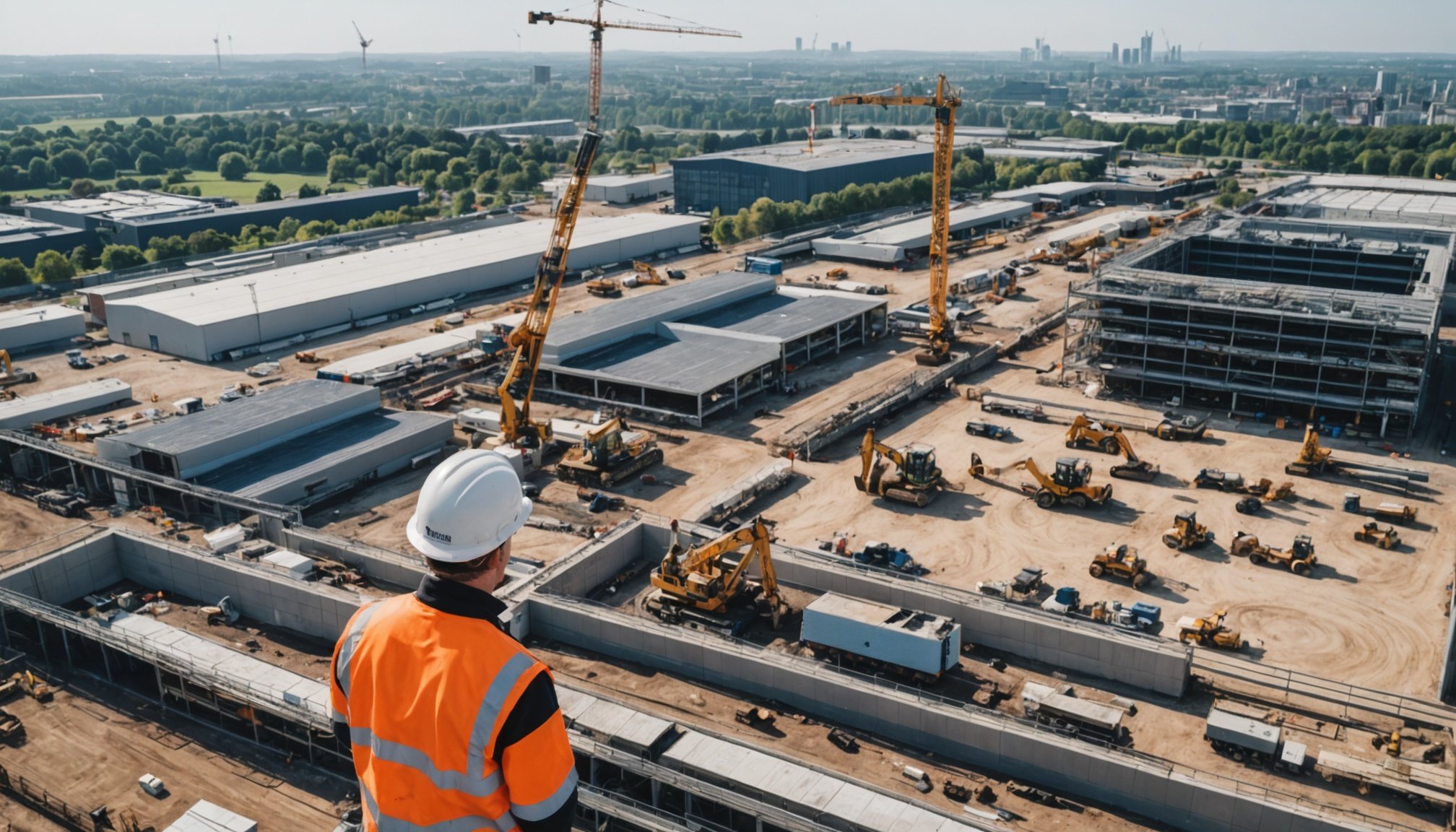Leveraging IoT in Multi-Site Construction Projects
IoT in construction offers transformative solutions that enhance the management of multi-site projects. By deploying smart devices and sensors across various locations, construction companies can gain real-time insights, facilitating improved coordination and communication. This technological shift is especially significant for UK construction firms managing projects over a broad geographical area.
The implementation of IoT in construction leads to operational efficiency by streamlining processes. Smart devices enable automation and precise monitoring, reducing human errors and increasing productivity. Moreover, IoT systems facilitate better resource allocation and time management through real-time data sharing, ensuring optimal performance even in complex multi-site environments.
In the UK, we see real-life examples of successful IoT integration. Firms such as BAM Nuttall and Costain have harnessed IoT tools to connect their workforce, optimise supply chains, and manage assets, proving the value of technology in everyday operations. These examples underscore the industry’s transition towards smarter, more connected construction sites, providing a competitive edge through enhanced efficiency.
To tap into the full potential of IoT, construction firms must understand and adopt these technologies, promoting a collaborative culture that embraces innovation in project management.
In the same genre : Elevate Inventory Management: Cutting-Edge AI Techniques for Retailers in the UK
Practical IoT Strategies for Enhancing Efficiency
Implementing effective IoT strategies can significantly amplify efficiency in construction projects. Key approaches involve integrating smart building technologies, deploying real-time data analytics, and utilising remote monitoring solutions.
Smart Building Technologies
Smart building technologies are pivotal in boosting construction efficiency. These include intelligent lighting, HVAC systems, and energy management solutions that adapt to real-time conditions and optimise resource use. By implementing these technologies, construction firms can drastically minimise costs and reduce project timelines through improved energy efficiency.
Real-time Data Analytics
Real-time data analytics plays a crucial role in enhancing project management. Sensors gather vital data across construction sites, allowing firms to perform predictive maintenance. This reduces downtime and avoids unexpected equipment failures, which can delay projects and inflate budgets.
Remote Monitoring Solutions
Remote monitoring solutions provide real-time access to project data, facilitating informed decision-making. By using sensors for monitoring site conditions, teams can manage sites efficiently from afar, addressing issues as they arise. This approach not only streamlines operations but also eases the burden of geographically dispersed multi-site management, ensuring optimal coordination and resource allocation.
Case Studies from UK Construction Firms
Examining real-life IoT case studies from prominent UK construction firms unveils the transformative impact of technology in achieving project success. These examples underline the tangible benefits and challenges that arise during IoT integration.
BAM Nuttall, a leader in infrastructure development, adopted IoT technology to monitor equipment health and optimize asset use. By incorporating sensors, they significantly reduced maintenance costs and minimised downtime, showcasing efficient project management.
Meanwhile, Costain focused on IoT solutions for enhancing on-site safety and procedural efficiency. Their approach included deploying wearable tech to monitor worker health. This innovative step not only improved safety but also raised overall productivity.
Throughout these ventures, common challenges, such as data security and ensuring technical compatibility, emerged. However, firms overcame these obstacles through stringent protocols and ongoing technological upgrades.
Key lessons learned emphasize the need for robust workforce training programs to maximize IoT tool usage. Effective training mitigates hesitation in technology adoption, ensuring smooth transitions and optimal multi-site management.
These examples underscore the potential of IoT to revolutionise construction practices, providing a blueprint for other companies aiming for technological advancement in the UK construction sector.
Addressing Implementation Challenges
Implementing IoT in construction projects comes with its unique set of challenges. Understanding these is critical for multi-site management and the seamless operation of UK construction firms.
Technology Integration Issues
A significant barrier is the integration of IoT solutions into existing systems. Compatibility issues can arise, affecting the smooth functioning of new technologies. Construction firms need strategic planning to ensure systems are updated to support IoT, avoiding technical roadblocks.
Workforce Training and Adaptation
Another challenge is equipping the workforce with the necessary skills to operate IoT technologies. Successful projects rely on a trained staff who are comfortable using these technologies. Training initiatives are essential to address this, ensuring staff can efficiently utilise IoT tools, which enables a smoother transition and minimises resistance to change.
Costs and Budget Management
Implementing IoT requires financial investment, which may pose a budget management challenge. Firms must prepare for upfront costs related to acquiring IoT devices and training personnel. It’s crucial to consider these factors in project planning. Strategically allocating funds ensures firms can efficiently adopt IoT technologies, ultimately leading to increased efficiency and streamlined operations. Avoiding budget overruns necessitates careful forecasting and cost allocation.
Regulatory Considerations for IoT in Construction
Understanding regulatory considerations is vital for implementing IoT in construction, especially for projects within the UK. Compliance with construction regulations ensures that IoT technologies are used responsibly and effectively across multi-site environments. The primary focus lies on data privacy and security since IoT devices collect significant amounts of sensitive information.
Several UK legislation pieces influence IoT use in construction, including the General Data Protection Regulation (GDPR) and specific health and safety statutes. These regulations mandate strict protocols for data handling, ensuring information gathered from IoT devices is managed with high confidentiality and integrity.
Industry standards also shape IoT technology use, promoting systems that are not only innovative but also secure and reliable. For instance, BSI (British Standards Institution) offers guidelines tailored to construction sites, providing frameworks for safe IoT integration.
Data security is not just about compliance but safeguarding trust. By prioritising secure IoT installations, companies can avert data breaches and enhance their reputation. IoT in construction, when compliant with regulatory demands, opens avenues for smarter, safer project management, aligning with national standards and fostering industry-wide trust.
Future Trends in IoT for Construction
Advancements in IoT are set to revolutionise construction innovation, offering transformative potential for the industry. Emerging IoT technologies promise to enhance efficiency through novel applications, such as drones for site surveys and augmented reality for virtual project walkthroughs. These innovations are expected to streamline multi-site management, providing comprehensive oversight and more synchronized operations.
Future of IoT in construction also includes hyper-connected equipment capable of autonomous performance monitoring. This seamless integration of technologies will further optimise project outcomes by delivering continuous data flow and precise analytics. Such developments will inevitably redefine traditional practices, setting new benchmarks for efficiency and coordination.
Predictions suggest significant benefits in long-term technology trends. As IoT systems evolve, the amalgamation of artificial intelligence and machine learning will become pivotal. This convergence will provide predictive insights, enhancing risk management and decision-making processes. The anticipated ROI from IoT investments is expected to multiply, fortifying productivity and fostering sustainable practices.
Adapting to these future trends requires construction firms to remain agile, ready to embrace breakthroughs that promise substantial returns. The future of IoT signals a strategic shift towards smarter, more responsive construction ecosystems.











